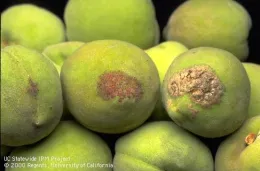
Peach leaf curl, also known as leaf curl, is caused by the fungus Taphrina deformans. It can affect the blossoms, fruit, leaves, and shoots of peaches, ornamental flowering peaches, and nectarines, and is one of the most common disease problems for backyard gardeners growing these trees. The fungal spores that cause the disease overwinter on tree twigs and buds. When the tree produces new leaves in spring, they become distorted and reddened and then fall off. The tree must then produce an entirely new crop of leaves, which weakens the tree. When severe, the disease affects fruit and can reduce production.
How can I prevent peach leaf curl?

When should I spray?
Spray after leaves have fallen and you have pruned your trees. Be sure to place the infected prunings in the greenwaste bin, not in your compost pile. The spores can remain in compost.Then, apply the copper solution to your tree, coating all the branches thoroughly. During wet winters, a second application can be made in late winter (January or February) just before or as flower buds swell, because heavy rainfall can wash away the fungicide. Once the tree leaves appear, it is too late to spray.
If I don't spray my tree to prevent leaf curl, what will happen?

Trees plagued by peach leaf curl for years can become stunted. If you miss the season to spray and your tree is infected, make sure to treat the following fall and/or winter to prevent more serious losses the following year.
The links below are excellent resources for information about peach leaf curl provided by the University of California Integrated Pest Management service. (UCIPM)
References & More Information
Pest Notes: Peach Leaf Curl https://ipm.ucanr.edu/home-and-landscape/peach-leaf-curl/pest-notes/#gsc.tab=0
Pruning Overgrown Fruit Trees https://anrcatalog.ucanr.edu/pdf/8058.pdf
Training and Pruning Fruit Trees https://anrcatalog.ucanr.edu/pdf/8057.pdf

